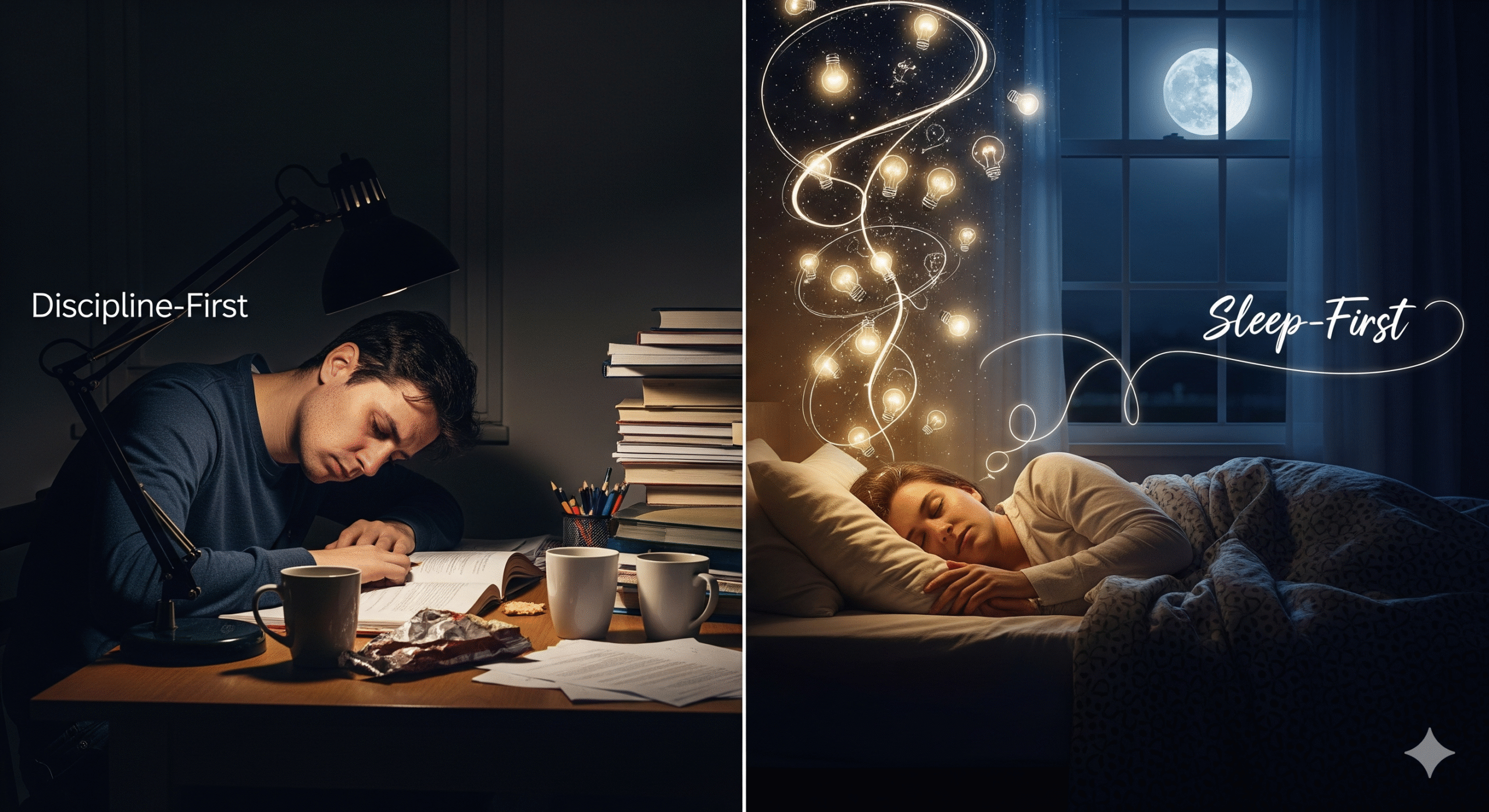To understand the transformative power of sleep, we must first look at what happens in our minds when we drift off. Sleep is not a passive state of rest; it’s an active period of intense neurological work. The brain uses this time to clean up, repair, and, most importantly, to process information from the day. This process is the key to unlocking creativity.
Licensed by GoogleSleep is a complex cycle with two main stages: Non-Rapid Eye Movement (NREM) and Rapid Eye Movement (REM). While NREM sleep is crucial for physical restoration and memory consolidation, it is the REM stage that is the true engine of creativity. During REM sleep, the brain is highly active, sometimes more so than when we are awake. It enters a state of what scientists call “free association,” where different parts of the brain communicate in a way they wouldn’t normally. This is why our dreams are often so bizarre and nonsensical—the brain is making strange and unexpected connections between seemingly unrelated memories and ideas.
History is filled with examples of creative breakthroughs that happened during or after sleep. The chemist August Kekulé famously discovered the ring-like structure of benzene after dreaming of a snake eating its own tail. The artist Salvador Dalí had a specific technique for unlocking creativity, where he would sit with a key in his hand over a plate. As he began to fall asleep, the key would drop, waking him up just in time to capture the surreal ideas that were forming in his mind. These aren’t just anecdotes; they are evidence of the powerful link between sleep and creativity.
A Tale of Two Mindsets: Discipline vs. Sleep
To truly understand the difference between the two approaches, it’s helpful to compare them directly. The “discipline-first” approach is the one that’s been glorified for decades, while the “sleep-first” approach is the one that is backed by modern science.
| Approach to Creativity | The Discipline-First Method | The Sleep-First Method |
| Primary Tool | Brute Force. Pushing through fatigue, working long hours, and relying on willpower. | Rest and Insight. Allowing the brain to work unconsciously, leading to fresh perspectives. |
| Mental State | Fatigued. The mind is tired, stressed, and often stuck in a linear, reductive thought pattern. | Refreshed. The mind is relaxed, clear, and capable of a wide range of associative thought. |
| Problem-Solving | Linear. Relies on established knowledge and known solutions. Tries to solve problems by repeating the same steps. | Associative. Makes unexpected connections between disparate ideas, leading to “aha!” moments and innovative solutions. |
| Idea Generation | Exhaustive. Ideas are generated through a forced, effortful process. Quantity often outweighs quality. | Insightful. Ideas emerge organically, often fully formed and elegant, after a period of rest. |
| Long-Term Impact | Burnout. Can lead to mental and physical exhaustion, reducing long-term creative output. | Sustainability. Leads to a sustainable creative practice, with consistent, high-quality output over time. |
Export to Sheets
This comparison reveals a crucial truth: discipline is about doing the work, but sleep is about making the work count. While discipline is necessary to sit down and put in the time, it is sleep that provides the insights that make the work truly original and groundbreaking.
The Secret Ingredient: How Sleep Enhances Creativity
So, what exactly is happening in our brains during sleep that makes it such a powerful creative tool? The benefits are multifaceted and work together to create the ideal conditions for innovation.
1. Information Consolidation and Pruning
Throughout the day, our brains are bombarded with information. Sleep acts as a kind of a mental “editor,” sifting through all the data we’ve taken in. It consolidates important memories into long-term storage and, more importantly, prunes away the irrelevant, distracting information. This process leaves the mind with a clear, organized canvas to work on, making it easier to see new patterns and connections. Without this “mental housekeeping,” our brains would be cluttered, and our thinking would be foggy.
2. The Power of Associative Thinking
As we mentioned, the REM stage of sleep is where the magic happens. During this phase, the brain’s executive control is suppressed, allowing different parts of the brain that don’t normally communicate to talk to each other. This is the neurological basis of “thinking outside the box.” Sleep helps the brain connect a concept you learned in a meeting to a random thought you had while walking your dog. It’s in this unexpected blending of ideas that the most original creative solutions are born.
3. Emotional Regulation and Problem-Solving
Stress and anxiety are the enemies of creativity. When we are stressed, our brains go into “fight or flight” mode, which narrows our focus and inhibits our ability to think flexibly. A good night’s sleep, particularly the REM stage, is crucial for processing and regulating emotions. By helping to reduce anxiety and stress, sleep frees up our mental energy, allowing our minds to be more open, flexible, and receptive to new ideas.
4. The “Aha!” Moment
How many times have you struggled with a problem all day, only to wake up the next morning with the solution? This is no coincidence. While you’re asleep, your brain is still working on the problem in the background. It’s making connections that your conscious mind, with its rigid and logical thinking, would never make. This process, often called “unconscious processing,” is what leads to those sudden, beautiful moments of insight that feel like they came out of nowhere.
The Pros and Cons: A Balanced View
While the evidence for the power of sleep and creativity is overwhelming, it’s important to provide a balanced view. A “sleep-first” approach is not a free pass to laziness; it’s a strategic choice.
Pros:
- Superior Idea Quality: Sleep-driven insights often lead to more original and elegant solutions.
- Reduced Burnout: Prioritizing sleep leads to a sustainable, long-term creative practice.
- Enhanced Problem-Solving: The brain’s ability to make new connections leads to a more flexible and innovative mindset.
- Improved Mood and Focus: A well-rested mind is less stressed, more focused, and more receptive to new ideas.
Cons:
- The Risk of Procrastination: An over-reliance on a “sleep-first” approach can be used as an excuse to avoid disciplined, hard work during waking hours.
- The Need for Input: Sleep cannot work with a blank slate. The brain still needs to be fed with new ideas, information, and challenges to process.
- Not a Magic Bullet: While sleep is a powerful tool, it doesn’t guarantee a creative breakthrough. It simply creates the best possible conditions for one.
- Misperception: In a culture that values visible effort, a “sleep-first” approach might be misunderstood or seen as a lack of dedication.
The key is to understand that sleep and creativity are not mutually exclusive from discipline. Instead, they are partners. Discipline is the work you do during the day to feed your mind, and sleep is the work your brain does at night to organize, synthesize, and create something new.
Use Cases: Who Should Embrace Sleep-First Creativity?
The benefits of prioritizing sleep for creative work are universal, but they are particularly impactful for certain professions and industries.
- Writers and Artists: Whether you’re working on a novel or a painting, the ability to find new narrative connections or visual themes is crucial. A good night’s sleep can help you overcome writer’s block and unlock fresh perspectives.
- Designers and Architects: The most elegant designs often come from unexpected sources. A designer can use sleep to synthesize seemingly unrelated concepts into a cohesive and original design.
- Programmers and Engineers: Complex coding problems often require a non-linear approach. Many programmers have experienced the feeling of getting stuck on a bug all night, only to solve it in minutes after waking up.
- Entrepreneurs and Innovators: In the business world, innovation is the key to success. Entrepreneurs can use sleep to find new business models or creative solutions to market problems.
- Students: A good night’s sleep before an exam or a major project is far more effective than an all-night cram session. It helps consolidate information and improve problem-solving skills.
FAQs: Your Questions on Sleep and Creativity Answered
How much sleep is needed for creativity?
Most research suggests that getting a full night’s sleep (7-9 hours) is optimal for creative function. It’s a misconception that you only need a few hours of sleep to be productive. The brain needs a full cycle of sleep, including the REM stage, to truly benefit from the creative process.
What happens to the brain during sleep?
During sleep, the brain is actively working to consolidate memories, prune away unnecessary information, and form new connections between different ideas. This is particularly true during the REM stage, where the brain engages in a process of “free association” that is crucial for creative problem-solving.
Can naps boost creativity?
Yes, short naps can be incredibly effective for boosting creativity. A “power nap” of 20-30 minutes can help restore focus and energy. Longer naps of around 90 minutes, which include REM sleep, can lead to the formation of new insights and connections.
Is the “sleep-deprived genius” a myth?
For the most part, yes. While some people may have a few bursts of creative energy during periods of sleep deprivation, these are unsustainable and often lead to reduced cognitive function, poor judgment, and burnout in the long run. The most sustainable and high-quality creative output comes from a well-rested mind.
What is the connection between sleep and memory?
Sleep plays a critical role in memory consolidation. During sleep, your brain replays and rehearses new information, moving it from short-term memory to long-term storage. This process makes it easier for you to recall information and use it to find creative solutions.
Conclusion: The Ultimate Creative Tool
In a world that screams at us to work harder, the quiet wisdom of our bodies whispers to us to rest. The evidence is clear: sleep and creativity are not just linked—they are fundamentally intertwined. Discipline is a vital tool, a hammer that allows us to build. But sleep is the blueprint, the very architecture of our greatest ideas.







Leave a Reply